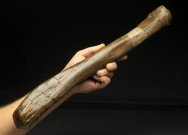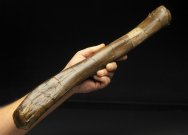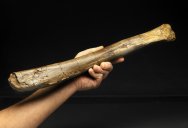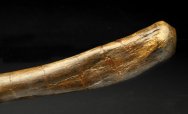 Description:
This is a large solid bone, the ulna (lower foreleg bone) of an
Edmontosaurus hadrosaurid dinosaur. Heavy in the hand, it has been
very well curated, is matrix free and exhibits quite nicely. It
would compliment any collection of dinosaur fossils. Description:
This is a large solid bone, the ulna (lower foreleg bone) of an
Edmontosaurus hadrosaurid dinosaur. Heavy in the hand, it has been
very well curated, is matrix free and exhibits quite nicely. It
would compliment any collection of dinosaur fossils.
The
great thing about fossil collecting is that anyone with a little
initiative, a bit of luck and some basic knowledge has the possibility
to make a wonderful discovery. According to the amateur collector,
“This bone was ID'd at The Black Hills Institute at Hill City,
SD as a Lower Front Leg Bone (ulna), 98% complete, from a HADROSAUR,
EDMONTOSAURUS, "DUCK BILL" DINOSAUR. The bone was found
on private land with permission of owner, "HELL CREEK FORMATION",
Perkins County, South Dakota. The bone was found in pieces and glued
back together using Palo Bond glues and cracks filled and painted
with a contrasting brown acrylic paint, then a coat of PVA was applied
over the whole bone. The light colored pieces were the ones that
first caught my attention and the rest were found in the ground
near by.”
Background:
The hadrosaurs are known as the duck-billed dinosaurs due to the
similarity of their head to that of modern ducks. In some species,
most notably Anatotitan, the whole front of the skull was flat and
broadened out to form a beak, ideal for clipping leaves and twigs
from the forests of Asia, Europe and North America. However, the
back of the mouth contained literally thousands of teeth suitable
for grinding food before it was swallowed. Hadrosaurs, like their
iguanodontian cousins, had a rudimentary dental specialization analogous
to incisors and molars. This has been hypothesized to have been
a crucial factor in the success of this group in the Cretaceous,
compared to the sauropods which were still largely dependent on
gastroliths for grinding their food.
|



